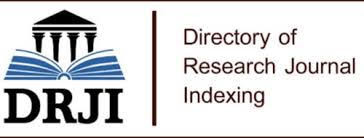Research Article
Medical Overview of Body Main Parts, Organs and their Functions
- Dr. Emin Taner Elmas
Corresponding author: Emin Taner Elmas, Assistant Professor, Dr., Vocational School of Higher Education for Technical Sciences, Division of Motor Vehicles and Transportation Technologies, Department of Automotive Technology, Igdir University, Turkey & Graduate School of Natural and Applied Sciences - Major Science Department of Bioengineering and Bio-Sciences, Iğdır University, Turkey.
Volume: 2
Issue: 1
Article Information
Article Type : Research Article
Citation : Emin Taner Elmas, Ismail Kunduracioglu. Medical Overview of Body Main Parts, Organs and their Functions. Journal of Medical and Clinical Case Reports 2(1). https://doi.org/10.61615/JMCCR/2025/APRIL027140415
Copyright: © 2025 Emin Taner Elmas. This is an open-access article distributed under the terms of the Creative Commons Attribution License, which permits unrestricted use, distribution, and reproduction in any medium, provided the original author and source are credited.
DOI: https://doi.org/10.61615/JMCCR/2025/APRIL027140415
Publication History
Received Date
29 Mar ,2025
Accepted Date
11 Apr ,2025
Published Date
15 Apr ,2025
Abstract
This article gives general information about the “Medical Overview of Body Main Parts and their Functions”.
The study has been realized within the scope of a Ph.D. lesson, which is lectured by Asst. Prof. Dr. Emin Taner Elmas. The name of this Ph.D. lesson is “Medical Engineering and Advanced Biomechanics” and is taught at the Major Science Department of Bioengineering and Bio-Sciences at Iğdır University, Turkey. İsmail KUNDURACIOĞLU is a Ph.D. student and one of the students taking this course. This article has been prepared within the scope of this Ph.D. lecture, as a part of one of his (İsmail KUNDURACIOĞLU) homework assignment tasks which was prepared using the summary translation of Reference [1]: Book Chapter 1. [1], [2], [3], [4], [5], [6], [7], [8], [9], [10], [11], [12], [13], [14], [15], [16], [17], [18], [19], [20], [21], [22], [23], [24], [25], [26], [27], [28], [29], [30], [31], [32], [33], [34], [35], [36], [37], [38], [39], [40], [41], [42], [43], [44], [45], [46], [47], [48], [49], [50], [51], [52], [53],[54], [55]
Keywords: Cells, Circulation, Heart, Kidneys, Respiratory System, Digestive System, Sensory Organs, Nervous System, Locomotor System, Skin, Reproductive System, Thermodynamics, Energy Transfer, Fluid Mechanics, Heat Transfer, Mathematics, Medical Technique, Medical Engineering, Medicine, Biomechanics, Biomechanical Analysis, Bioengineering, Health Science.
►Medical Overview of Body Main Parts, Organs and their Functions
Emin Taner Elmas1*, Ismail Kunduracioglu2
1*Assistant Professor, Dr., Vocational School of Higher Education for Technical Sciences, Division of Motor Vehicles and Transportation Technologies, Department of Automotive Technology, Igdir University, Turkey & Graduate School of Natural and Applied Sciences - Major Science Department of Bioengineering and Bio-Sciences, Iğdır University, Turkey, e.taner.elmas@igdir.edu.tr
2Lecturer, Technology Transfer Office, Iğdır University & Ph.D. Student Graduate School of Natural and Applied Sciences - Major Science Department of Mechatronics Engineering, Iğdır University, Turkey, ismail.kunduracioglu@igdir.edu.tr
Introduction
1. Main Body Parts and Functions
The human body is a complex and highly organized system that works together to ensure survival and maintain homeostasis. The body, which is composed of trillions of cells, each of which is vital to sustaining life, performs its functions through the tissues, organs, and organ systems that these cells form. Each of these systems contributes to overall health by maintaining the balance of the internal environment through biochemical and mechanical interactions. While body parts and functions are controlled by chemical processes, it is an often overlooked fact that movement, forces, torques, and mechanical stability also play important roles. The body's energy balance is based on the principles of thermodynamics, while sensory systems operate according to acoustic and optical principles. On the other hand, respiration, blood circulation, and the kidneys are subject to the laws of diffusion, hydrostatics, and hydrodynamics. Nerve conduction can be described in terms of electrical circuits. Each organ and system, through complex biological processes and mechanical functioning, ensures that the body survives and maintains its functionality. [1]
The circulatory system, driven by the heart, facilitates the transport of oxygen, nutrients, hormones, and metabolic waste, while the kidneys filter the blood and regulate fluid and electrolyte balance. The respiratory system manages gas exchange, while the digestive system provides the nutrients needed for cellular repair. Sensory organs perceive external stimuli, and this data is processed by the nervous system, allowing the body to respond appropriately. The musculoskeletal system supports movement and structural integrity, while the integumentary system protects the body from external threats and helps with thermoregulation. The reproductive system ensures the continuation of the species, ensuring the transmission of genetic material from generation to generation. This article will discuss the structure, function, and importance of each major system in detail, emphasizing the interconnected roles of these systems in maintaining the overall health and balance of the human body. [1], [2], [3], [4], [5], [6], [7], [8], [9], [10], [11], [12], [13], [14], [15], [16], [17], [18], [19], [20], [21], [22], [23], [24], [25], [26], [27], [28], [29], [30], [31], [32], [33], [34], [35], [36], [37], [38], [39], [40], [41], [42], [43], [44], [45], [46], [47], [48], [49], [50], [51], [52], [53],[54], [55]
Method, Findings, and Discussion
2.1 Cells
The human body is made up of trillions of cells, and these cells form the building blocks of the body. Each cell is specialized to perform a specific function and works in harmony with other cells to maintain the integrity and health of the body. Cells function as structures surrounded by a plasma membrane that contains organelles that regulate cellular activities. Human cells are nucleated structures and contain genetic material (DNA) in their nuclei. DNA controls the life processes in trillions of cells, which carry genetic information and have approximately 20,000 genes. This genetic information enables the synthesis of proteins, and these proteins perform many vital functions of the body.[1]
Each cell functions as a microscopic “factory” that drives complex biological processes. Mitochondria serve as the cell’s powerhouses, producing ATP and supporting metabolic processes. The endoplasmic reticulum and Golgi apparatus play important roles in protein and lipid synthesis, while lysosomes break down cellular waste and manage recycling mechanisms. Cells are divided into different categories based on structure and function; for example, muscle cells have the ability to contract, while nerve cells transmit electrical signals, enabling rapid communication.[1]
However, while all cells have the same genetic information, each is specialized for different functions. Cells grow and repair through cellular division. Mitosis allows body cells to multiply, while meiosis produces reproductive cells. Cells are also sensitive to environmental factors, hormones, and other chemical signals, allowing cellular signaling pathways to play an important role in maintaining the integrity of the organism and maintaining health.[1]
Cellular biology is of great importance in the fields of medicine and biotechnology. Understanding cellular functioning allows for the development of new methods for diagnosing and treating diseases. For example, it is possible to prevent the uncontrolled division of cancer cells by examining the cell cycle. In addition, stem cell research opens the door to important developments in regenerative medicine, which allows for the repair of damaged tissues. As a result, cells are the smallest functional units of the body and play critical roles in maintaining health and the sustainability of the organism. Therefore, understanding cellular functioning makes significant contributions to the development of biological sciences.[1]
2.2 Circulatory System
The circulatory system is a complex and vital network that transports the substances necessary for the body to maintain its vital functions. The transport of oxygen, nutrients, hormones and waste products in the body is achieved through this system. The circulatory system consists of the heart, blood vessels, and cellular components in the blood. The heart works like a pump and directs blood to the body and lungs, while blood vessels serve as lines that carry these substances. Blood vessels are divided into three main types: arteries, veins, and capillaries. While arteries carry oxygen-rich blood from the heart to the body, veins carry oxygen-poor blood back to the heart and have one-way valves that prevent blood from flowing backward. Capillaries, on the other hand, provide the exchange of substances between the tissues and the blood, allowing oxygen and nutrients to pass into the cells and waste to be removed.[1]
Figure 1:Human Circulatory System Diagram[1]

Blood circulation is divided into two main components: major (systemic) and minor (pulmonary) (Figure 1). In the major circulation, oxygen-rich blood is pumped from the heart to the body, providing cells with the oxygen and nutrients they need to produce energy. Blood that is depleted of oxygen returns to the heart via the veins to carry away carbon dioxide and metabolic waste. In the minor circulation, blood is directed to the lungs, where it is enriched with oxygen and returned to the heart for redistribution throughout the body. This circulation continues continuously thanks to the rhythmic contractions of the heart. The heart consists of four chambers: two atria and two ventricles. The atria receive blood, while the ventricles pump blood to the body and the lungs. Proper blood circulation also contributes to important functions such as regulating body temperature, maintaining pH balance, and strengthening immune defenses. For example, white blood cells fight pathogens as part of the immune system, while the dilation and constriction of blood vessels help regulate body temperature. Additionally, the circulatory system plays a critical role in maintaining electrolyte levels and pH balance in the body.[1]
The disruption of the circulatory system can lead to serious health problems. Diseases such as atherosclerosis, hypertension, and heart attack can occur due to disruptions in the circulatory system. A healthy lifestyle, regular exercise, a balanced diet, and avoiding risk factors such as smoking are important to ensure the optimal functioning of the circulatory system.[1]
2.3 Heart
The heart is an organ that works with rhythmic contractions and electrical impulses, which are vital for the body to sustain life. Located in the chest cavity, the heart consists of four chambers, each chamber performing a specific function. The atria collect blood circulating in the body and transfer it to the ventricles, while the ventricles pump blood to the lungs and the entire body. While oxygen-poor blood is received from the right atrium and sent to the right ventricle, the left atrium receives oxygen-rich blood and transfers it to the left ventricle. The left ventricle has the strongest muscular wall and pumps oxygenated blood throughout the body (Figure 2).[1]
Figure 2: Human Heart Diagram[1]

The heart muscle (myocardium) is a powerful muscle that works involuntarily and is triggered by electrical signals. The heart performs its contractions and blood pumping in a synchronized manner, thanks to these signals initiated by the sinus-atrial node, which produces regular electrical signals. The heart beats an average of 60-100 times per minute and pumps 7,500 liters of blood into the body by contracting approximately 100,000 times per day. This rhythmic movement is the main function of the heart, which ensures the continuity of the circulatory system. In order for the heart to work regularly and efficiently, the oxygen and nutrients it receives from the coronary arteries play a critical role in maintaining its contraction power.[1]
2.4 Kidneys
The kidneys are vital bean-shaped organs that maintain the body’s homeostasis (Figure 3). They are located on the back wall of the abdominal cavity, on either side of the spine, and each contains about one million nephrons. Nephrons are the basic functional units of the kidneys, filtering waste products from the blood to produce urine. The glomerulus, a cluster of capillaries, filters the blood, while the Bowman capsule transfers fluid and small molecules to the tubule system. During this process, water and minerals necessary for the body are reabsorbed while waste products are excreted in the urine.[1]
Figure 3:Lateral Section of the Kidney[1]

Other important functions of the kidneys include regulating fluid and electrolyte balance, maintaining acid-base balance, and controlling blood pressure. Through the renin-angiotensin-aldosterone system (RAAS), the kidneys secrete hormones to help balance blood pressure when it drops. In addition, the kidneys produce erythropoietin, which stimulates the production of red blood cells in the bone marrow, thus supporting oxygen transport. The kidneys play a critical role in maintaining internal homeostasis while also removing harmful waste from the body.[1]
Protecting kidney health is of great importance for a healthy life. Healthy lifestyle habits such as adequate water consumption, balanced diet, salt intake control, and regular exercise ensure proper kidney function. In addition, conditions that can lead to kidney diseases, such as diabetes and hypertension, should be kept under control. Since kidney dysfunction can lead to serious health problems, early diagnosis and treatment are of great importance in improving the quality of life.[1]
2.5 Respiratory System
The respiratory system is a vital system that allows the body to take in oxygen and remove waste gases such as carbon dioxide. Consisting of the nose, pharynx, larynx, trachea, bronchi, bronchioles, and lungs, this system performs a specific function to ensure efficient gas exchange. The respiratory process consists of four main stages: ventilation (intake and expulsion of air), external respiration (exchange of oxygen and carbon dioxide in the lungs), gas transport (transport of oxygen through the blood), and internal respiration (use of oxygen in the cells).[1]
The alveoli are the central locations for these processes, where oxygen passes into the bloodstream, while carbon dioxide is expelled through respiration to be expelled. Respiration occurs through the cooperation of the ribcage and diaphragm; air is taken in and expelled through this mechanism. In addition, the respiratory system is regulated by the medulla oblongata and pons regions of the brain. An increase in carbon dioxide levels in the body increases the respiratory rate and provides balance. In addition, the respiratory system contributes to voice production, olfaction, and immune functions. The larynx, which contains the vocal cords, enables speech, while receptors in the nose detect odors, and microorganisms are expelled from the body through mucus and cilia in the respiratory tract.[1]
For a healthy respiratory system, it is important to stay away from smoking, breathe clean air, exercise regularly, and protect the respiratory tract from irritants. Respiratory system diseases can lead to health problems such as asthma, COPD, and pneumonia, and these are usually caused by air pollution, smoking, and infections. In conclusion, the respiratory system not only helps sustain life by providing oxygen intake but also plays a critical role in removing metabolic waste and maintaining balance in the body.[1]
2.6 Digestive System
The digestive system is a complex system that provides the body with the nutrients needed for energy production and to obtain the components needed for cellular functions. This system consists of a process that includes the mechanical and chemical breakdown of ingested food, digestion, absorption, and the excretion of indigestible waste. The digestive process begins in the mouth; the teeth mechanically break down food, while the salivary glands begin the digestion of carbohydrates. Food is shaped by the tongue and swallowed and passed to the stomach through the esophagus.[1]
The stomach, with its strong muscular structure and acidic environment, allows food to be broken down into smaller pieces. Stomach acid and the pepsin enzyme start the digestion of proteins, turning them into smaller polypeptides. The stomach content turns into an acidic mixture called chyme, which passes into the duodenum. The small intestines are the most important section where digestion is completed and nutrients are absorbed. Here, enzymes secreted by the pancreas and bile salts secreted by the gallbladder allow fat, protein, and carbohydrates to be broken down into smaller components. The jejunum and ileum sections of the small intestine are the areas where digested nutrients are absorbed. Here, villi and microvilli increase the absorption capacity, allowing nutrients to be transported to the blood and lymphatic system. The large intestine, where undigested food residues pass, allows water and electrolytes to be reabsorbed. Beneficial bacteria in the large intestine help ferment indigestible fibers and synthesize some vitamins. At the end of these processes, feces are formed and stored in the rectum and excreted through the anus.[1]
The digestive system is regulated by the nervous system and hormonal mechanisms. For example, the hormone gastrin increases stomach acid secretion, while the hormones secretin and cholecystokinin regulate the functions of the pancreas and gallbladder. A healthy digestive system supports the overall health of the body by ensuring optimal nutrient absorption and proper elimination of waste. An unbalanced diet, stress, infections, and disorders of the intestinal flora can all lead to digestive problems. Digestive diseases include GERD, gastritis, ulcers, IBS, and inflammatory bowel disease. The digestive system plays a vital role in meeting the body's energy and nutrient needs. The coordinated interaction between the digestive organs and accessory structures ensures that nutrients are used efficiently, and a healthy digestive system is a key element in supporting the body's overall health.[1]
2.7 Sensory Organs
Sensory organs are specialized organs that perceive the world around us and transmit it to our brains via the nervous system. The human body is equipped with five main sensory organs: eyes, ears, nose, tongue, and skin. Each is specialized to detect a specific environmental stimulus, allowing us to detect changes in our environment and respond accordingly.[1]
The eye is the center of vision and receives light waves and transmits them to the brain. The retina is made up of light-sensitive cells and processes visual information by converting light energy into electrical signals. The ear perceives sound waves and converts these waves into electrical signals and transmits them to the auditory center. In addition, the inner ear is responsible for maintaining balance and detects the body's position and movement through the vestibular organ. The nose provides the sense of smell and detects odor molecules through receptor cells sensitive to chemicals in the air, then transmits them to the brain to identify odors. The tongue is the center of taste and detects tastes (sweet, salty, sour, and bitter) through taste buds. The skin collects sensory information such as touch, pressure, temperature, and pain, thus increasing our sensitivity to our environment.[1]
Sensory organs not only perceive environmental information but can also transmit signals related to internal organs. For example, there are pressure sensors for the bladder and colon and sensors that detect hunger and thirst. In addition, sensors related to biological functions such as sexual desire reach the brain via sensory organs. However, humans do not have sensors that detect electric and magnetic fields. Such senses are present in some animals, such as fish and birds. Similarly, altitude is perceived indirectly through oxygen deficiency and pressure changes in the middle ear. It greatly assists the brain in signal processing and decision-making processes. Each organ helps us perceive the world around us, directing our body's interaction with the external environment and allowing our brain to respond correctly.[1]
2.8 Nervous System
The nervous system is a complex network of the brain, spinal cord, and peripheral nerve fibers that processes, analyzes, and responds to information received from the body's internal and external environment. Basically, the nervous system is divided into two main components: the central nervous system (CNS) and the peripheral nervous system (PNS). The central nervous system consists of the brain and spinal cord. The brain is the main center that controls all body functions and manages processes such as thinking, movement, memory, sensory perception, and emotions. The spinal cord provides information transmission between the brain and other parts of the body. The peripheral nervous system communicates between the central nervous system and the rest of the body and consists of two main components: sensory nerves and motor nerves. Sensory nerves perceive environmental stimuli (such as temperature, pressure, and pain) and transmit this information to the central nervous system, allowing it to respond to environmental changes. Motor nerves, on the other hand, coordinate the body's physical responses by transmitting movement commands received from the brain and spinal cord to the muscles.[1]
The functions of the nervous system can be divided into two main categories: the somatic nervous system and the vegetative nervous system. The somatic nervous system controls conscious sensation and muscle movement, while the vegetative nervous system regulates the functions of the internal organs. These two systems are connected by sensory (afferent) and motor (efferent) connections. Afferent connections transmit signals from the periphery to the center (brain or spinal cord), while efferent connections send signals from the central nervous system to the periphery. The vegetative nervous system consists of two main subsystems: sympathetic and parasympathetic. The sympathetic nervous system increases the body's performance and helps it cope quickly with dangerous situations.
The parasympathetic nervous system calms the organs and saves energy. The balanced functioning of these two systems is critical for optimal organ functionality. The nervous system also plays an important role in maintaining homeostasis. It maintains the balance between organs, adapts to environmental changes, and uses the body's energy resources efficiently. The proper functioning of the nervous system is a basic requirement for a healthy life.[1]
2.9 Movement System
The movement system is a structure that enables the physical movements of the body and enables all body functions to occur properly. This system consists of bones, muscles, joints, tendons, cartilage, and connective tissues. While bones provide structure to the body, they also provide the rigid support necessary for movement. They also contribute to the production of blood cells through the bone marrow. Joints enable mobility by providing the connection between bones. Muscles, on the other hand, move the joints by connecting to the bones and directing the physical activities of the body. The movement system is classified into three main groups: skeletal muscles, smooth muscles, and cardiac muscles. Skeletal muscles are the muscles that provide the external movement of the body and work voluntarily. These muscles respond by contracting after receiving electrical signals (action potentials) from nerve fibers. Smooth muscles control the movement of internal organs and work involuntarily. The cardiac muscle is a special type of muscle that performs the pump function of the heart.[1]
The brain and spinal cord are well protected in the skull and spinal canal, respectively, while the skeletal system provides less protection but increases the body's mobility and flexibility. The functioning of the locomotor system is based on a cooperation that allows muscles to move joints by contracting and relaxing. The initiation of muscle movement occurs through a sequential sequence of action potentials controlled by the central nervous system. The locomotor system enables the body to respond to its environment, move, carry loads, and perform various tasks. The proper functioning of this system is a basic requirement for a healthy life, and the health of muscles and bones is directly related to overall body health.[1]
2.10 Leather
The skin is the largest organ in the body and plays a critical role in providing protection from environmental factors and performing various biological functions. Covering an area of approximately 2 m² in adults, the skin provides structural support to the body and interacts with the external environment. It collects sensory information, such as touch. It also regulates body temperature, provides loss of excess heat through sweating, and provides heat production through shivering. In addition to protecting from environmental damage, the skin also protects the internal organs against mechanical impacts, temperature changes, microorganisms, chemicals, and radiation. Melanin pigments, which prevent damage from UV rays, are also found in the skin, thus protecting the skin against the harmful effects of the sun.[1]
The skin consists of three main layers: the epidermis, dermis, and hypodermis. The epidermis is the uppermost part of the skin surface and contains keratin protein, which prevents water loss. It also protects the skin against ultraviolet rays by containing melanin pigment. The dermis is the connective tissue located under the epidermis and contains blood vessels, nerve endings, sweat glands, and sebaceous glands. Nerve fibers in the dermis allow sensory information to be perceived from the outside. The hypodermis is the fatty tissue under the skin that helps protect the body from temperature fluctuations and also has shock absorbing properties.[1]
The skin functions as an exchange system; it produces the components the body needs while expelling waste products. The body maintains fluid balance and regulates body temperature through sweat glands in the skin. The skin contains protective substances that prevent microbes from entering the body, making it the first line of defense. Since inadequate care can lead to skin diseases and infections, the skin is an essential organ for a healthy body and requires regular protection and care.[1]
2.11 Reproductive system
The reproductive system is a set of organs and structures that allow the production of new individuals. The human reproductive system contains different structures for men and women and plays a critical role in ensuring the continuation of the species. The male reproductive system is responsible for sperm production and transportation. In this system, the testicles produce sperm, which are then expelled through the epididymis, vas deferens, seminal vesicles, and urethra. The female reproductive system includes organs that produce eggs and develop the fetus. The ovaries produce an egg each month, which travels through the fallopian tube to the uterus. If fertilized by sperm, the embryo begins to develop in the uterus. If fertilization does not occur, the egg is expelled from the uterus.[1]
The male reproductive organs include the penis, testicles, epididymis, sperm ducts, and prostate; while the female reproductive organs include two ovaries, two fallopian tubes, uterus, vagina, and breasts.
The prostate and breast are among the organs most affected by cancerous tissues. The reproductive system is regulated by hormones, and these hormones direct the processes necessary for healthy reproduction. The menstrual cycle in women and spermatogenesis in men are the basic functions of the reproductive system.[1]
Each aspect of the body shows the magnitude of its complexity. The reproductive system follows a series of building blocks that are similar to all mammals, starting at the cellular level. Just as animal studies play an important role in medical and physiological research, the knowledge provided about this complex functioning of the human body is also becoming more profound with advancing technologies. In the future, biotechnological innovations, interfaces between the nervous system and electronics, and developments such as smart prosthetics will continue to contribute to reproductive health and treatments.[1], [2], [3], [4], [5], [6], [7], [8], [9], [10], [11], [12], [13], [14], [15], [16], [17], [18], [19], [20], [21], [22], [23], [24], [25], [26], [27], [28], [29], [30], [31], [32], [33], [34], [35], [36], [37], [38], [39], [40], [41], [42], [43], [44], [45], [46], [47], [48], [49], [50], [51], [52], [53],[54], [55]
Conclusion
This article provides an overview of the organs and systems that form the basic building blocks of the human body. The healthy functioning of the body is ensured through the interactions of each organ and system, both individually and with each other. Starting from the basic structural units of cells to vital systems that sustain life, such as circulation, nervousness, digestion, and respiration, each part of the body is part of a complex interconnected network.
The heart, kidneys, and other internal organs perform the basic functions of the body, while sensory organs perceive environmental stimuli and transmit them to the nervous system to adapt the body. The locomotor system provides flexibility and strength that enable the body to interact with the environment, while the skin plays a critical role in both protecting against external factors and regulating body temperature. The reproductive system has a special function to ensure the continuity of the species.
It has been observed that each organ and system works in harmony in the body to sustain life. The body forms a whole by complementing each other with each of its components. This complex structure is constantly being examined in depth not only in the field of health but also in biomedical research, treatment methods, and technological developments. Understanding this unique functioning of the human body allows for the development of more innovative solutions in both medical and scientific research.[1], [2], [3], [4], [5], [6], [7], [8], [9], [10], [11], [12], [13], [14], [15], [16], [17], [18], [19], [20], [21], [22], [23], [24], [25], [26], [27], [28], [29], [30], [31], [32], [33], [34], [35], [36], [37], [38], [39], [40], [41], [42], [43], [44], [45], [46], [47], [48], [49], [50], [51], [52], [53],[54], [55]
- Hartmut Zabel. (2017). Volume 1: Medical Physics, Physical Aspects of Organs and Imaging, ISBN: 978-3-11- 037281-6, Walter de Gruyter GmbH, Berlin/Boston.
- Elmas, Emin Taner, ELMAS’s Theory of Thermodynamics”. (2020). A Scientific Approach for 5th Law of Thermodynamics -A Theoretical Application Example for Medical Thermodynamics. Op Acc J Bio Sci & Res. 2(1).
- Emin Taner ELMAS. (2024). Medical Treatment Method of Alzheimer's Disease & Parkinson’s Disease by the Help of the Natural Musical Sound of Nây-ı Şerîf, Instrument of Ney (Ney: Turkish Reed Flute, Nay). IJCMCR. 42(3): 004.
- Elmas, Emin Taner. (2020). Medical Treatment Method of “Bio-robotic Resonance and Thermodynamical Interaction” with Analogy of “Frequency – Resonance Setting Formation” on the Application of “Algorithm for Smart Drugs Controlled by a Bio-robotic System” developed for the “Treatment of Covid-19, Coronavirus and Virus Infections”. Open Access Journal of Biogeneric Science and Research (BGSR), Op Acc J Bio Sci & Res. 1: 1.
- Elmas Emin Taner. (2020). Scope of Applications for Medical Technique at Science and Engineering, Open Access Journal of Biogeneric Science and Research (BGSR), Op Acc J Bio Sci & Res. 1: 1.
- Emin Taner ELMAS. (2024). System Design and Development of a Novel Unique Neuro-Physical Medical Treatment Method for SMA-SPINAL MUSCULAR ATROPHIA-Disease and for Similar Neurological Muscle Diseases. Herculean Res. 4(1): 90-97.
- Fevzi Daş, Emin Taner Elmas and İhsan Ömür Bucak, Book Chapter: Innovative Use of Machine Learning-Aided Virtual Reality and Natural Language Processing Technologies in Dyslexia Diagnosis and Treatment Phases; From the Edited Volume Digital Frontiers - Healthcare, Education, and Society in the Metaverse Era. (2024). Written By Fevzi Daş, Emin Taner Elmas and İhsan Ömür Bucak, IntechOpen Limited, UNITED KINGDOM; indexed in the Book Citation Index in Web of Science™ Core Collection (BKCI).
- Emin Taner ELMAS. (2024). Design of Bionic Eye and Artificial Vision System; a Unique Project “Mobile Bio-Eye-Tronic System”. Herculean Res. 4(1): 97-100.
- Emin Taner ELMAS. (2024). Project for “Amphibious Mobile Snow Track Ambulance” for Healthcare System. Am J Biomed Sci & Res. 22(4). AJBSR.MS.ID.002990.
- Emin Taner ELMAS. (2024). The first “Olive Seedlings” and “Artichoke Seedlings” Planted in Iğdır Province, Turkey. Am J Biomed Sci & Res. 2024 22(5) AJBSR.MS.ID.002996.
- Emin T. Elmas, İhsan Ö. Bucak. (2023). Modeling and Simulation of Smart-Drug Algorithms Through Frequency Modulation for the Treatment of Covid-19 and Similar Viruses. Global Journal of Research in Medical Sciences. 3(5): 1–6.
- Emin T. E İhsan Ömür B. (2024). FM Modulated Smart Drug Algorithm for the treatment of Cancer Cells. In Global Journal of Research in Medical Sciences. 4(1): 1–6.
- Emin Taner ELMAS. (2023). Prototype Desıgn, Productıon and Functıonıng of a Portable (Movable), Home-Type (Domestıcal) Hemodıalysıs Machıne (Unıt). In Global Journal of Research in Medical Sciences. 3(6): 11–12.
- Elmas, Emin Taner. (2019). Thermodynamical Balance Associated with Energy Transfer Analysis of the Universe Space as a Pressure Vessel Analogy. Journal of Applied Sciences, Redelve International Publications. 2019(1): RDAPS- 10002.
- Elmas, Emin Taner. (2017). Productivity and Organizational Management (The Book) (Chapter 7): Prospective Characteristics of Contemporary Engineer (By the Approach of Mechanical Engineering) Contribution and Role of the Mechanical Engineer to the Organization Management and Productivity. Machado Carolina, Davim J Paulo (Eds.), DEGRUYTER, Walter de Gruyter GmbH, Berlin / Boston, Spain. 180-182.
- Elmas, Emin Taner. (2017). Prospective Characteristics of Contemporary Engineer (By the Approach of MechanicalEngineering) Contribution and Role of the Mechanical Engineer to the Organization Management and Productivity). DeGruyter, Germany.
- ELMAS, Emin Taner ALMA, M. H. (2025). Iğdır University ISO 50001 Energy Management System Certification Studies. In Global Journal of Research in Engineering & Computer Sciences. 5(2): 6–24.
- Hartmut Zabel. (2017). Medical Physics, Volume2: Radiology, Lasers, Nanoparticles and Prosthetics, ISBN: 978-3-11- 055310-9, Walter de Gruyter GmbH, Berlin/Boston.
- Steven Vogel. (2013). Comparative Biomechanics – Life’s Physical World, Published by Princeton University Press, ISBN:978-0-691-15566-1, USA.
- Roland Ennos. (2012). Solid Biomechanics, Published by Princeton University Press, ISBN:978-0-691-13550-2, USA.
- Mark Strikman, Kevork Spartalian, Milton W. Cole. (2015). Applications of Modern Physics in Medicine, Princeton University Press, ISBN:978-0-691-12586-2, USA.
- Emin Taner Elmas. (2024). Design of Bio-Artificial Liver Organ. J Biomed Sci Biotech Res. 2(3): 1-4.
- ELMAS, E. T. (2024). Design of Bionic Ear-Cochlear Implant and Artificial Hearing System; a Unique Project “Mobile Bio-Ear-Tronic System”. Journal homepage. 4(2).
- Emin Taner Elmas. (2024). A Review for Combined Cycle Power Plants. Bi¬omed J Sci & Tech Res. 58(1). BJSTR. MS.ID.009087.
- ELMAS, Emin Taner. (2024). Dimensional Unit Analysis Applications for Heat Pipe Design. In Global Journal of Research in Engineering & Computer Sciences. 4(5): 12–26.
- ELMAS, Emin Taner. (2024). Calculation of the Filling Amount of Working Fluid to be Placed in a Heat Pipe. In Global Journal of Research in Engineering & Computer Sciences. 4(5): 100–108.
- ELMAS, Emin Taner. (2024). Providing Fully Developed Flow for Waste Exhaust Gas at the Inlet Region of a Heat Pipe Air Recuperator. In Global Journal of Research in Engineering & Computer Sciences. 4(5): 118–124.
- Emin Taner Elmas. (2024). ONLINE BOOKLET - E -Print - A Review for Combined Cycle Power Plants. 58(1)-2024.
- Emin Taner ELMAS, Doktora (Ph.D.) Tezi, “Yüksek Sıcaklıklı, Isı Borulu, Isı Geri Kazanım Ünitelerinin Tasarım Parametrelerinin Termodinamiksel ve Deneysel Analizi”, Tez Danışmanı:Prof. Dr. Ali Güngör, Ege Üniversitesi Fen Bilimleri Enstitüsü Makina Mühendisliği Anabilim Dalı, Termodinamik Bilim Dalı, İzmir, 2011.
- Elmas, Emin Taner. (1999). Yüksek Lisans (M.Sc.) Tezi, “Evaporation Plant For Recyling of Caustic Soda”, Thesis Advisor: Prof. Dr. Fehmi Akdoğan, Dokuz Eylül Üniversitesi Fen Bilimleri Enstitüsü Makina Mühendisliği Anabilim Dalı, Enerji Bilim Dalı, İzmir.
- Emin Taner E. (2023). Thermodynamical And Experimental Analysis of Design Parameters of a Heat Pipe Air Recuperator. Global Journal of Research in Engineering & Computer Sciences, 3(6): 7–33.
- Emin T. E. (2023). Design, Production, Installation, Commissioning, Energy Management and Project Management of an Energy Park Plant Consisting of Renewable Energy Systems Established at Igdir University. In Global Journal of Research in Engineering & Computer Sciences. 3(6): 67–82.
- ÇELİK ÜRETİMİNDE ELEKTRİK ARK OCAKLARINDA ENERJİ MALİYETLERİNİN VE ENERJİ VERİMLİLİK FAKTÖRLERİNİN ARAŞTIRILMASI INVESTIGATION ON ENERGY COSTS AND ENERGY EFFICIENCY FACTORS OF ELECTRIC ARC FURNACE FOR STEEEL PRODUCTION. (2021). Fenerbahçe Üniversitesi Tasarım, Mimarlık ve Mühendislik Dergisi - Journal of Design, Architecture & Engineering Hasan TAMSÖZ, Emin Taner ELMAS. 1(3): 163-180.
- SİNTER TESİSLERİNDE ENERJİ KULLANIM NOKTALARI VE ENERJİYİ VERİMLİ KULLANACAK YÖNTEMLERİN BELİRLENMESİ DETERMINATION OF ENERGY UTILIZATION POINTS AND THE METHODS USING THE EFFICIENT ENERGY FOR SINTERING PLANTS. (2022). Fenerbahçe Üniversitesi Tasarım, Mimarlık ve Mühendislik Dergisi - Journal of Design, Architecture & Engineering Adem KAYA, Emin Taner ELMAS. 2(2): 170-181.
- Emin Taner ELMAS. (2024). The Electrical Energy Production Possibility Research Study by using the Geothermal Hot Water Resources, which is a a kind of Renewable Energy Resource, located at the Region of Mollakara Village which is a part of Diyadin Town and City of Ağrı, Turkey. In Global Journal of Research in Engineering & Computer Sciences. 4(1): 90–101.
- ELMAS, Emin Taner. (2024). Energy Analysis, Energy Survey, Energy Efficiency and Energy Management Research carried out at Iğdır University. In Global Journal of Research in Engineering & Computer Sciences. 4(2): 12–30.
- ELMAS, Emin Taner. (2024). A Research Study of Salt Dome (Salt Cave) Usage Possibility for CAES – Compressed Air Energy Storage Systems. In Global Journal of Research in Engineering & Computer Sciences. 4(2): 128–131.
- ELMAS, Emin Taner. (2024). Wankel Rotary Piston Engine Design Project. In Global Journal of Research in Engineering & Computer Sciences. 4(4): 1–4.
- ELMAS, Emin Taner. (2024). An innovative solar dish type collector – concentrator system having an original – unique geometrical mathematical model called as DODECAGON which has 12 equal segments. In Global Journal of Research in Engineering & Computer Sciences. 4(3): 31–38.
- Emin Taner ELMAS. (2024). Waste Heat Recovery Boilers (WHRBs) and Heat Recovery Steam Generators (HRSGs) used for Co-generation and Combined Cycle Power Plants. Op Acc J Bio Sci & Res. 12(1).
- ELMAS, Emin Taner. (2024). Presentation and Curriculum of Division of Motor Vehicles and Transportation Technologies & Department of Automotive Technology at Vocational School of Higher Education for Technical Sciences at Iğdır University, Turkey. In Global Journal of Research in Engineering & Computer Sciences. 4(3): 60–67.
- Emin Taner ELMAS. (2023). Design and Production of a Unique Hand-Made Energy-Efficient 4 x 4 – Four Wheel Drive (4wd – 4 Matic) Traction System Electric Automobile. In Global Journal of Research in Engineering & Computer Sciences. 3(6): 48–51.
- ELMAS, Emin Taner. (2024). Three – Pass Fire Tube Boilers for production of Steam, Hot Water and Superheated Water. In Global Journal of Research in Engineering & Computer Sciences. 4(4): 29–38.
- Elmas, Emin Taner. (2017). Evaporation Plant for Recycling of Caustic Soda, INTERNATIONAL JOURNAL of ENGINEERING TECHNOLOGIES-IJET Emin Taner Elmas. 3(3): 176-185.
- Elmas, Emin Taner. (2014). Çağımızın Mühendisinden Beklenenler, Gece Kitaplığı. ISBN:9786053244158.
- Emin Taner ELMAS and Levent OĞUL. (2025). The Effects of Medicine and Music Therapy Practices on Human Health. IJCMCR. 50(2): 003.
- Emin Taner E, Servet K. (2025). Biomechanical Analysis of Transtibial Prosthesis Designed for Runners. Biomedical and Clinical Research Journal. 1(2).
- ET Elmas and MA Cinibulak. (2025). Fundamental Scientific and Technical Issues related with the “Hip Replacement Design and Biomechanical Analysis”. Journal of Material Science and Nanotechnology, Matsci Nano J. 1(1).
- Kunduracioğlu, İ. (2018). Examining the Interface of Lego Mindstorms Ev3 Robot Programming. Journal of Educational Technology & Online Learning. 1(1): 28–46.
- Kunduracioglu, I. (2024). CNN Models Approaches for Robust Classification of Apple Diseases. Computer and Decision Making: An International Journal. 1: 235–251.
- Kunduracioglu, I. (2024). Utilizing ResNet Architectures for Identification of Tomato Diseases. Journal of Intelligent Decision Making and Information Science. 1: 104–119.
- ELMAS, Emin Taner, & KUNDURACIOĞLU, I. (2025). A Model for Second Law of Thermodynamics, Relationship between Health, Disease, Aging, Death Processes and Consciousness, Nervous System and Time. In Global Journal of Research in Medical Sciences. 5(2): 1–6.
- ELMAS, Emin Taner, & KUNDURACIOĞLU, I. (2025). Metabolic Heat Production with Energy Transfer and Laws of Human Thermodynamics: The Energy Balance of the Human Body. In Global Journal of Research inMedical Sciences. 5(2): 7–14.
- Elmas ET, Kunduracıoğlu I. (2025). Artificial Heart Design and Biomechanical Analysis. Open Access Journal of Medicine and Healthcare, Research Article. 1(1): 01-06.
- ELMAS, Emin Taner, & KUNDURACIOĞLU, I. (2025). Fundamentals of Human Vision System. In Global Journal of Research in Medical Sciences. 5(2): 103–117.
Download Provisional PDF Here
PDF




p (1).png)




.png)




.png)
